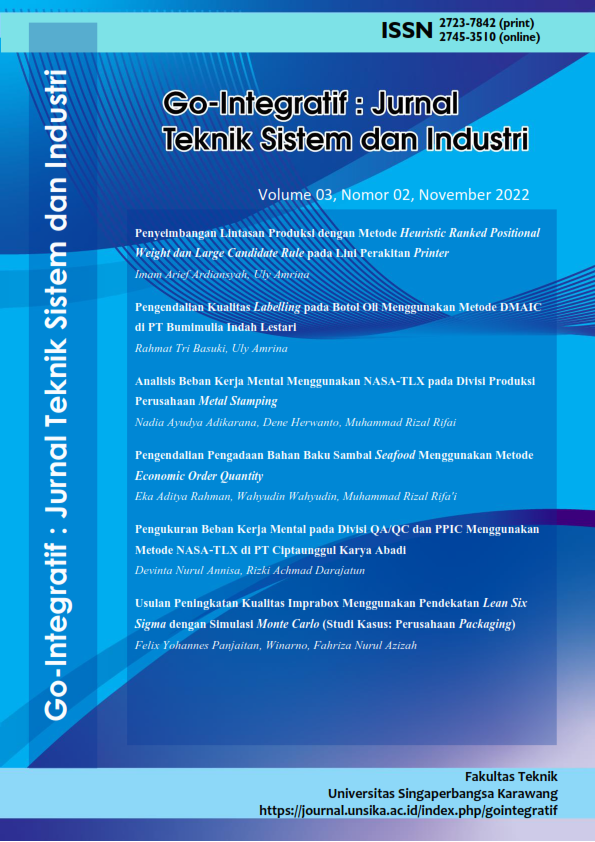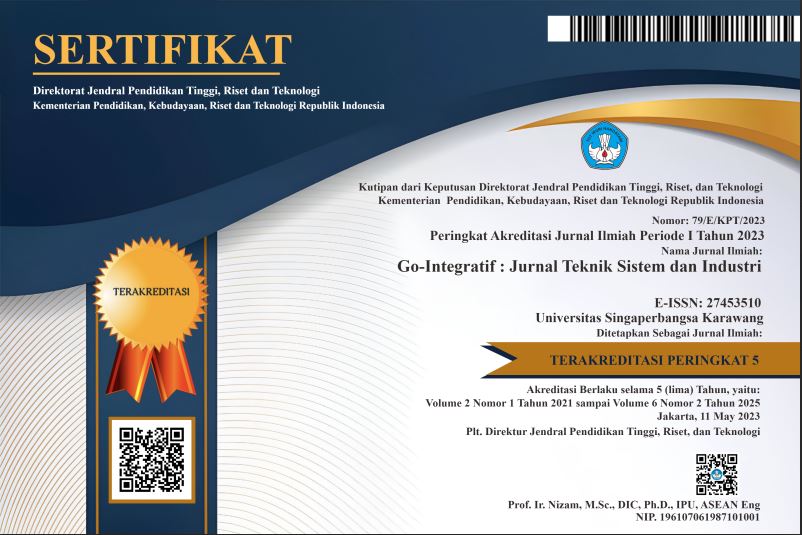Analisis Beban Kerja Mental Menggunakan NASA-TLX pada Divisi Produksi Perusahaan Metal Stamping
DOI:
https://doi.org/10.35261/gijtsi.v3i02.7151Abstract
Human resources as one of the company's assets must be considered because they affect the performance of the company. Metal stamping companies that apply the make to order and make to stock concepts in processing each of their products lead to a high number of requests that need to be achieved every day by workers. Workers have to work 8 and a half hour/day. The purpose of this study is to analyze the factors that affect the mental workload as well as the proposed improvements needed based on the working conditions of the workers. The method used is NASA-TLX, a subjective measurement method of mental workload. This method is in the form of a questionnaire which distributed to 10 workers in the Production Division. The results from this study indicate that the average WWL score is 61.07 and is in the high category. Then it is known factors that affecting are the high target demand each day, the rest time is quite low, the heat from the stamping process, the lack of training on the machines on the production floor. The proposals given are increasing rest periods, holding regular training, providing adequate facilities.
Downloads
References
G. K. Karo and E. Adianto, “Pengukuran Produktivitas Karyawan Dengan Metode Full Time Equivalent (FTE) PT. Astra International Tbk Divisi Astra Motor Penempatan Jakarta Honda Center,” JIEMS (Journal Ind. Eng. Manag. Syst., vol. 7, no. 1, pp. 81–87, Mar. 2017, doi: 10.30813/jiems.v7i1.111
C. Basumerda, “Analisis Beban Kerja Karyawan dengan Menggunakan Metode SWAT dan NASA-TLX (Studi Kasus di PT LG Electronic Indonesia),” Matrik J. Manaj. dan Tek. Ind. Produksi, vol. 20, no. 1, pp. 13–24, Sep. 2019, doi: 10.30587/matrik.v20i1.856.
Sedarmayanti, Sumber Daya Manusia Dan Produktivitas Kerja, III. Bandung: CV. Mandar Maju, 2009.
H. Qonita and P. W. Laksono, Analisis Beban Kerja Mental dengan Metode NASA-TLX pada Operator Recycling Warehouse Material di PT.XYZ,” Prosiding Seminar dan Konferensi Nasional IDEC 2022, 2022, p. A22.1-A22.7.
R. Ramadhan, I. P. Tama, and R. Y. Efranto, “Analisa Beban Kerja dengan Menggunakan Work Sampling dan NASA-TLX untuk Menentukan Jumlah Operator (Studi Kasus: PT XYZ),” J. Rekayasa dan Manaj. Sist. Ind., vol. 2, no. 5, pp. 131–165, 2014.
A. T. Septiansyah, R. Fitriani, and B. Nugraha, “Mental Work Load Analysis Melalui National Aeronautics and Space Administration (NASA)-Task Load Index (TLX),” J. Sains dan Teknol. J. Keilmuan dan Apl. Teknol. Ind., vol. 21, no. 2, pp. 282–291, Dec. 2021, doi: 10.36275/stsp.v21i2.419.
M. R. Asyidikiah and D. Herwanto, “Analisis Beban Kerja Mental Manajemen Divisi Engineering Menggunakan National Aeronautical and Space Administration (NASA)-TLX,” J. Serambi Eng., vol. 7, no. 2, pp. 2983–2990, Apr. 2022, doi: 10.32672/jse.v7i2.3937.
G. A. Yudhistira, M. A. Febrianti, and M. A. Fathurrohman, “Analisis Beban Mental Pekerja untuk Perbaikan Sistem Kerja pada Konveksi XYZ dengan Metode NASA-TLX,” Performa Media Ilm. Tek. Ind., vol. 19, no. 2, pp. 103–112, 2020, doi: 10.20961/performa.19.2.46426.
N. Rahdiana, R. Arifin, and A. Hakim, “Pengukuran Beban Kerja Mental di Bagian Perawatan di PT. XYZ Menggunakan Metode NASA-TLX,” Go-Integratif J. Tek. Sist. dan Ind., vol. 2, no. 01, pp. 1–11, May, 2021, doi: 10.35261/gijtsi.v2i01.5076.
D. C. Dewi, “Analisa Beban Kerja Mental Operator Mesin Menggunakan Metode Nasa Tlx Di Ptjl,” J. Ind. View, vol. 2, no. 2, pp. 20–28, 2020, doi: 10.26905/4881.
H. Iridiastadi and Yassierli, Ergonomi Suatu Pengantar. Bandung: PT Remaja Rosdakarya, 2014.
P. A. Hancock and N. Meshkati, Eds., Human Mental Workload. Amsterdam: Elsevier Science Publisher B.V., 2011.
H. Widananto and D. D. Nugraheni, “Analisis Beban Kerja Mental pada Pekerja di Industri Pembuatan Tempe,” Tekinfo J. Ilm. Tek. Ind. dan Inf., vol. 7, no. 2, pp. 87–94, May 2019, doi: 10.31001/tekinfo.v7i2.607.
Downloads
Published
How to Cite
Issue
Section
License
Copyright (c) 2022 Nadia Ayudya Adikarana, Dene Herwanto, Muhammad Rizal Rifa'i

This work is licensed under a Creative Commons Attribution-NonCommercial-ShareAlike 4.0 International License.







